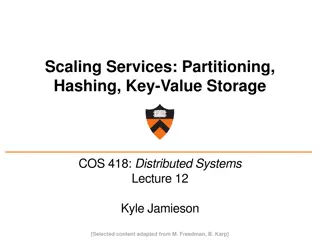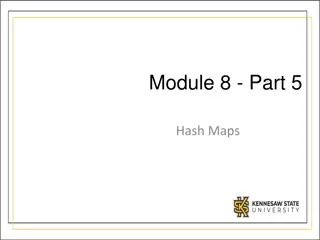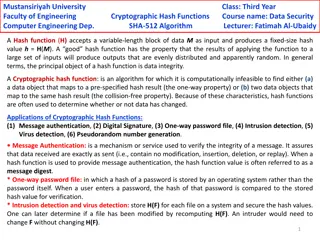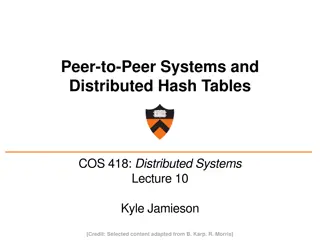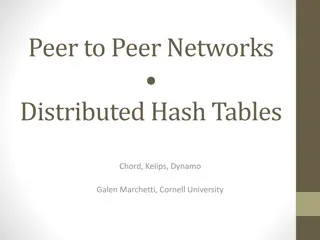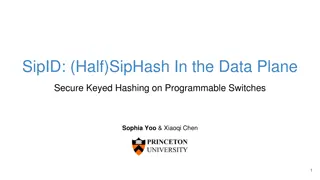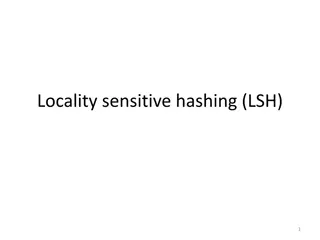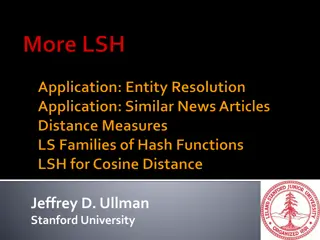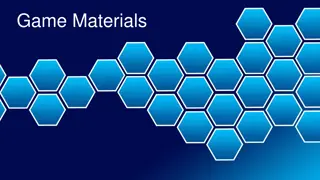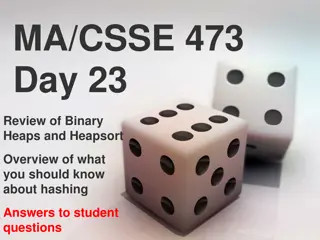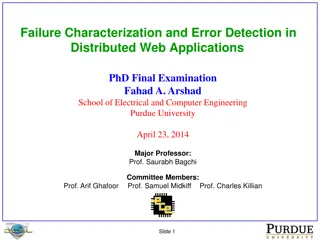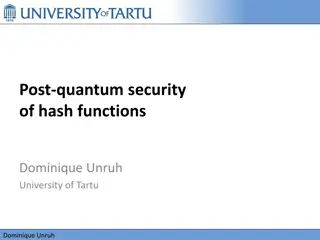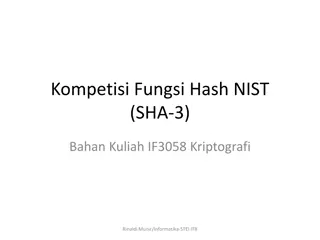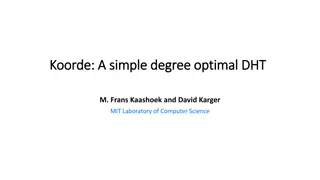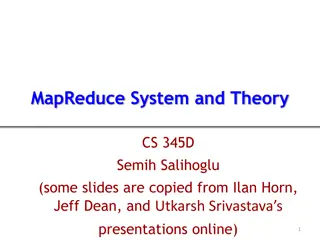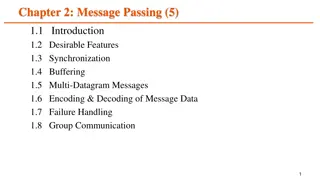Understanding Consistent Hashing and Distributed Hash Table
Explore the concept of consistent hashing and distributed hash tables to efficiently store and retrieve web pages across multiple servers. Learn how hashing functions and algorithms can distribute data evenly, handle server additions smoothly, and minimize object relocations. Discover the benefits of consistent hashing in managing large amounts of data effectively.
Download Presentation

Please find below an Image/Link to download the presentation.
The content on the website is provided AS IS for your information and personal use only. It may not be sold, licensed, or shared on other websites without obtaining consent from the author. Download presentation by click this link. If you encounter any issues during the download, it is possible that the publisher has removed the file from their server.
E N D
Presentation Transcript
Consistent Hashing and Distributed Hash Table Chen Qian Department of Computer Science & Engineering qian@ucsc.edu https://users.soe.ucsc.edu/~qian/
Motivating question Suppose we have a large amount of web pages to store over 100 servers. How can we know where a webpage (identified by a url) is stored, among the 100 servers? Do we have a method simpler than using a complete directory? 2
Simple Solution Using Hashing Let us use a mapping from all web pages to all servers A hash functions maps elements of a universe U to buckets A good hash function: 1. Easy to compute 2. Uniformly random 3
Say there are n servers, indexed by 0, 1, 2, , n-1. Then we can just store the Web page with URL x at the cache server named h(x) mod n. Problem: Suppose we add a new server and n is now 101. For an object x, it is very unlikely that h(x) mod 100 and h(x) mod 101 are the same number, Thus, changing n forces almost all objects to relocate. 4
Each object is mapped to the next bucket that appears in clockwise order on the unit circle. Consistent Hashing Server Object 5
Consistent Hashing Server Object Failure 6
Consistent Hashing Server Object 7
Consistent Hashing Server Object Add a server or the server is online again 8
The object and server names need to be hashed to the same range, such as 32-bit values. n servers partition the circle into n segments, with each server responsible for all objects in one of these segments. in expectation, adding the nth server causes only a 1/n fraction of the objects to relocate. 9
In practice Using binary search tree to find the server responsible for an object If you pick n random points on the circle, you're very unlikely to get a perfect partition of the circle into equal-sized segments. Decrease this variance is to make k virtual copies" of each server s 10
Pros? Cons? 11
P2P: searching for information Index in P2P system: maps information to peer location (location = IP address & port number) 12
Distributed Hash Table (DHT) DHT = distributed P2P database Database has (key, value) pairs; key: content name; value: IP address Peers query database with key database returns values that match the key Peers can also insert (key, value) pairs into database Finding needles requires that the P2P system be structured 13
Chord: A Scalable Peer-to-peer Lookup Protocol for Internet Applications Ion Stoica Robert Morris David Karger Frans Kaashoek Hari Balakrishnan Slides by Xiaozhou Li
distributed hash table Distributed application put(key, data) get (key) data Distributed hash table . node node node DHT provides the information look up service for P2P applications. Nodes uniformly distributed across key space Nodes form an overlay network Nodes maintain list of neighbors in routing table Decoupled from physical network topology 15
Routed queries (Chord) N2 N1 N3 Client N4 Publisher Key = beat it Value = MP3 data Lookup( beat it ) N7 N6 N8 N9 16
Routing challenges Define a useful key nearness metric Keep the hop count small Keep the tables small Stay robust despite rapid change Chord: emphasizes efficiency and simplicity 17
Chord properties Efficient: O(log(N)) messages per lookup N is the total number of servers Scalable: O(log(N)) state per node Robust: survives massive failures Proofs are in paper / tech report Assuming no malicious participants 18
Chord overview Provides peer-to-peer hash lookup: Lookup(key) return IP address Chord does not store the data How does Chord route lookups? How does Chord maintain routing tables? 19
Chord IDs Key identifier = SHA-1(key) Node identifier = SHA-1(IP address) Both are uniformly distributed Both exist in the same ID space How to map key IDs to node IDs? The heart of Chord protocol is consistent hashing 20
Review: consistent hashing for data partitioning and replication 1 E replication factor N=3 0 hash(key1) A C hash(key2) F B D 1/2 A key is stored at its successor: node with next higher ID 21
Identifier to node mapping example Node 8 maps [5,8] Node 15 maps [9,15] Node 20 maps [16, 20] Node 4 maps [59, 4] 4 58 8 15 Each node maintains a pointer to its successor 44 20 35 32 22
Lookup lookup(37) 4 Each node maintains its successor 58 8 node=44 Route packet (ID, data) to the node responsible for ID using successor pointers 15 44 20 35 32 23
Join Operation Node with id=50 joins the ring via node 15 Node 50: send join(50) to node 15 Node 44: returns node 58 Node 50 updates its successor to 58 succ=4 pred=44 4 58 8 join(50) succ=58 succ=nil pred=nil 15 58 50 44 succ=58 pred=35 20 35 32 24
Periodic Stabilize succ=4 pred=50 pred=44 Node 50: periodic stabilize Sends stabilize message to 58 Node 50: send notify message to 58 Update pred=44 4 stabilize(node=50) notify(node=50) 58 8 succ.pred=44 succ=58 pred=nil 15 50 44 succ=58 pred=35 20 35 32 25
Periodic Stabilize succ=4 pred=50 Node 44: periodic stabilize 4 Asks 58 for pred (50) 58 Node 44 updates its successor to 50 8 stabilize(node=44) succ=58 pred=nil 15 50 44 succ=50 succ=58 pred=35 20 35 32 26
Periodic Stabilize succ=4 pred=50 Node 44 has a new successor (50) 4 58 Node 44 sends a notify message to node 50 8 succ=58 pred=44 pred=nil 15 notify(node=44) 50 44 succ=50 pred=35 20 35 32 27
Periodic Stabilize Converges! pred=50 This completes the joining operation! 4 58 8 succ=58 50 pred=44 15 44 20 succ=50 35 32 28
Achieving Efficiency: finger tables Say m=7 Finger Table at 80 0 i ft[i] 0 96 1 96 2 96 3 96 4 96 5 112 6 20 (80 + 26) mod 27 = 16 112 80 + 25 20 96 32 80 + 24 80 + 23 80 + 22 80 + 21 45 80 + 20 80 n+ i m ith entry at peer with id n is first peer with id >= ) 2 (mod 2 Each node only stores O(log N) entries Each look up takes at most O(log N) hops 29
Achieving Robustness What if nodes FAIL? Ring robustness: each node maintains the k (> 1) immediate successors instead of only one successor If smallest successor does no respond, substitute the second entry in its successor list Unlikely all successors fail simultaneously Modifications to stabilize protocol (see paper!) 30
Cooperative File System (CFS) Block storage Availability / replication Authentication Caching Consistency Server selection Keyword search DHash distributed block store Chord Lookup Powerful lookup simplifies other mechanisms 31
Cooperative File System (cont.) Block storage Split each file into blocks and distribute those blocks over many servers Balance the load of serving popular files Data replication Replicate each block onk servers Increase availability Reduce latency (fetch from the server with least latency) 32
Cooperative File System (cont.) Caching Caches blocks along the lookup path Avoid overloading servers that hold popular data Load balance Different servers may have different capacities A real server may act as multiple virtual servers, by being hashed to several different IDs. 33
Problem of DHT No good solution to maintain both scalable and consistent finger table under Churn. Solution of BitTorrent Maintain trackers (servers) as DHT, which are more reliable Users queries trackers to get the locations of the file File sharing are not structured. 34
Next class Please read Chapter 3-4 of the textbook BEFORE Class 35
Thank You Chen Qian cqian12@ucsc.edu cqian12@ucsc.edu https://users.soe.ucsc.edu/~qian/ https://users.soe.ucsc.edu/~qian/






